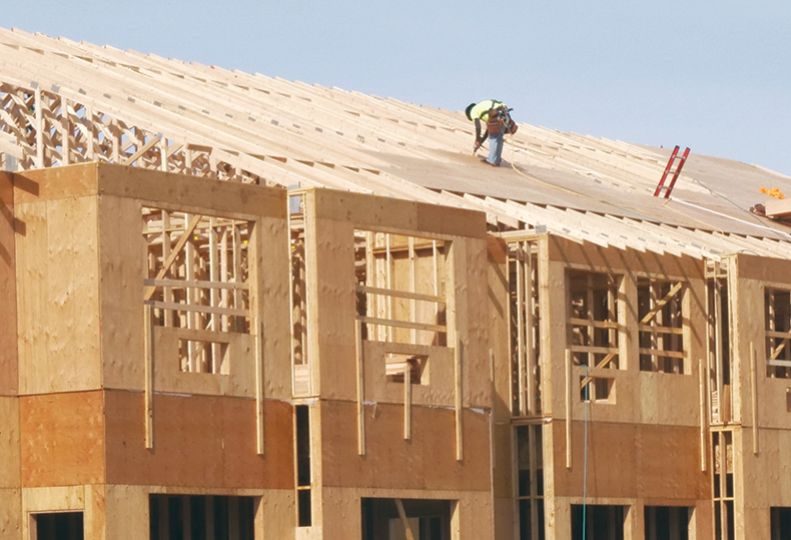
Home » Building blocked: Construction costs hinder financing
Building blocked: Construction costs hinder financing
Lenders seek solutions as contractors scale down some projects

June 16, 2022
Some lenders here say they’re working around challenges to finance commercial construction developments and keep projects moving forward despite soaring prices of construction materials and rising labor costs, which have resulted in some project delays and cancellations.
Aliza Seay, president of Spokane Valley-based Northwest Business Development Association, says the amount of time borrowers have to lock in an interest rate for a construction project has changed because of rising construction costs—from six months to between 90 and 120 days.
“That’s really been a challenge to our applicants because the construction industry is so busy and with increasing costs, it’s been a challenge to meet that deadline,” Seay says. “The other impact is that because of the increased cost of materials, they’ve been cancelling and postponing projects.”
Jim Frank, CEO of Greenstone Corp., a Liberty Lake-based real estate development company, concurs and says Greenstone has cut back on certain projects under development in the last three months because of soaring costs. The company obtains financing for its larger commercial projects, including some developments in the Kendall Yards neighborhood, but it self-finances residential subdivision developments.
Frank declines to disclose the specific projects Greenstone has had to scale back due to increased costs in recent months.
A U.S. construction outlook, released in May by the Associated General Contractors of America, reports that in two years, from April 2020 to April 2022, prices of construction materials have climbed significantly for steel products, which have grown 107%. In addition, lumber and plywood prices climbed 89%; copper and brass metal products increased 77%; aluminum metal products, 72%; plastic construction products, 49%; and truck transportation of freight increased 41% in the same time frame.
In the meantime, construction bid prices have been unable to keep pace, only growing 23% for nonresidential building construction, signaling some projects are unlikely to get off the ground as they become financially unfeasible.
Seay says, “We’ve seen our construction projects on 504 lending drop dramatically. We are busy in terms of other lending. We’re absolutely having a fantastic year, but it’s not from a lot of construction projects.”
U.S. Small Business Administration-backed 504 loans can be up to $5 million and are meant to be used for major purchases, such as a building, large fixed assets, and major equipment.
She says NWBDA has seen an uptick in commercial refinance activity, which has helped offset the decline in commercial development loans.
Seay explains that refinance loans offered by the nonprofit organization have fixed rates.
“A lot of the commercial market is getting ready to reprice in the next three to five years, so in the increasing-rate market, they’re looking for a fixed rate, and that’s what we can offer,” Seay explains.
The average loan at NWBDA in fiscal year 2021 was $877,000, compared with an average 2022 loan of $1.07 million as of April 30, Seay says.
NWBDA is a certified development company licensed by the U.S. Small Business Administration to help administer and manage the SBA 504 loan program. The organization provides secondary construction financing behind a third-party lender or bank that typically puts up 50% of the loan amount. NWBDA can provide financing for about 40% of the loan, and the applicant would be responsible for the remaining 10%.
“That first loan with the third-party lender or the bank will often be a variable rate that resets every three or five years, depending on the program. But our portion is always fixed for the life of the loan and that’s why with commercial real estate we can go out to 25 years at a fixed rate.”
Saif Hakim, Seattle-based vice president and commercial lending manager for Craft3, says the longer the process takes, the more fluctuation there likely will be.
“Any lender doing construction financing has an understanding that costs are increasing daily and weekly, so making sure we approach loans with the right budget items in place ... and doing the due diligence up front helps our flexibility.”
Craft3’s due diligence includes a constructability analysis to provide an idea of the current market conditions along with the latest material and labor prices and the direction they’re heading to understand how, and in which areas, developers will spend their project financing.
“We have noticed, as the process takes anywhere from 90 to 120 days depending on the size and scope of the project, that as we get closer to closing, there have been changes in budget,” Hakim says. “The main point for us as a lender in that arena is to be flexible and have the ability to restructure and find ways to mitigate costs to help the deal get across the finish line.”
Craft3 offers loans for smaller projects, that typically cost under $200,000, as well as offering supplemental loans for larger construction projects, similar to how NWBDA finances commercial development loans.
Megan Hulsey, commercial lender at Craft3’s Spokane office, says the nonprofit is experiencing an increase in lending activity in the current market.
Traditional lenders are requiring greater value of collateral and better credit scores before taking on a commercial loan and are referring commercial borrowers to Craft3 for project financing as they tighten lending requirements, she says.
Greenstone’s Frank says the biggest challenge to get commercial development moving forward is labor costs. He adds that demand is still strong, but low employment levels in the industry have caused delays and cancellations, driving up the cost of developments.
“Cheap labor no longer exists,” Frank says.
He says rising labor costs in the local construction industry can be attributed to retiring baby boomers leaving the workforce; remote working positions; child care costs that can limit a workers’ ability to return to onsite work settings; higher paying job opportunities in other industries; and a lower level of immigration that the industry previously relied on for laborers.
Frank predicts the high cost of labor will continue for the next few years because commercial developers didn’t invest in capital improvements to increase efficiency before the labor crisis began.
“Investing in those capital improvements to become more efficient will take years,” he says.
Latest News Special Report Real Estate & Construction Banking & Finance
Related Articles
Related Products





_web.jpg?1729753270)